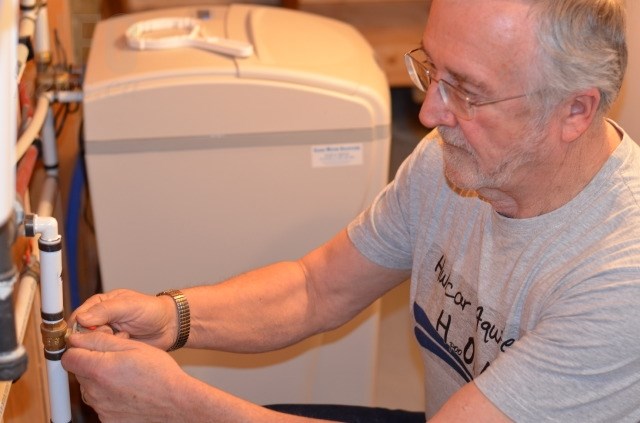
FILE PHOTO: In this file photo from February 2016, Spallumcheen resident Al Price can be seen with the water filtration system he bought on his own after nitrate levels spiked in the water supply. Now, the province is planning to switch some residents to an alternate water source, and provide point of entry water treatment for others.
(CHARLOTTE HELSTON / iNFOnews.ca)
March 10, 2017 - 4:30 PM
SPALLUMCHEEN - Spallumcheen residents affected by a longstanding water quality advisory could have clean water pouring out of their taps by the fall, according to Shuswap MLA Greg Kyllo.
He says the $950,000 investment announced last week by the provincial government will be used to bring relief to residents who have been on an advisory since 2014 due to high nitrate levels in their water. High nitrate levels in drinking water are associated with a number of serious medical conditions including ‘blue baby’ syndrome in infants, cancer, and thyroid gland dysfunctions.
One option is connecting Steele Springs Water District with the nearby Otter Lake Water District. For individual well users, the province is looking at point of entry water treatment. Whatever route is decided on, Kyllo says the funding will be enough to completely fund the work.
“It’s certainly my hope that we’ll see residents connected to an alternative water source, or have water treatment in their homes, by fall,” Kyllo says.
READ MORE: North Okanagan residents can't stomach liquid manure in their water
The funding announcement has been criticized by the NDP for coming two months prior to the provincial election when the issue has been going on for years, but Kyllo says ministry staff needed time to gather the facts and determine the best course of action.
“I certainly agree that all of us would’ve liked to have seen some of the information flow earlier, but it’s very complicated work,” Kyllo says.
He says the decision to commit the $950,000 came as a result of a recent nitrate study and environmental impact assessment indicating the Hullcar Aquifer would not return to safe levels for upwards of ten years. He says the results were 'surprising' given the aquifer showed some signs of improvement last summer.
“With that new information — that the aquifer won’t return itself to a healthy state in the near future — was why there is a more immediate demand for relief for the residents,” Kyllo says.
His understanding is there are 53 affected residences connected to the Steele Springs Water District, 22 private well users, and four wells servicing roughly 50 people in the Splatsin First Nation.
“I would say there’s definitely been a sense of frustration in the Hullcar Valley,” Kyllo says. “I would have liked, in hindsight, to have found out some of this information sooner, but it does take some time to better identify exactly where the sources of nitrates are.”
In terms of the specific source, Kyllo says his understanding is a “significant portion of the nitrates are coming from the farming community.”
Because the aquifer is shallow and unconfined, he says it is particularly susceptible to changes on the land base.
That’s why part of the funding will be used to develop and implement nutrient management plans for farms located over the Hullcar Aquifer, Kyllo says.
“We do not want to lose focus on the need to restore the Hullcar Aquifer to a healthy state,” he says.
Read previous stories on the Hullcar Aquifer here.
To contact a reporter for this story, email Charlotte Helston or call 250-309-5230 or email the editor. You can also submit photos, videos or news tips to the newsroom and be entered to win a monthly prize draw.
We welcome your comments and opinions on our stories but play nice. We won't censor or delete comments unless they contain off-topic statements or links, unnecessary vulgarity, false facts, spam or obviously fake profiles. If you have any concerns about what you see in comments, email the editor in the link above.
News from © iNFOnews, 2017